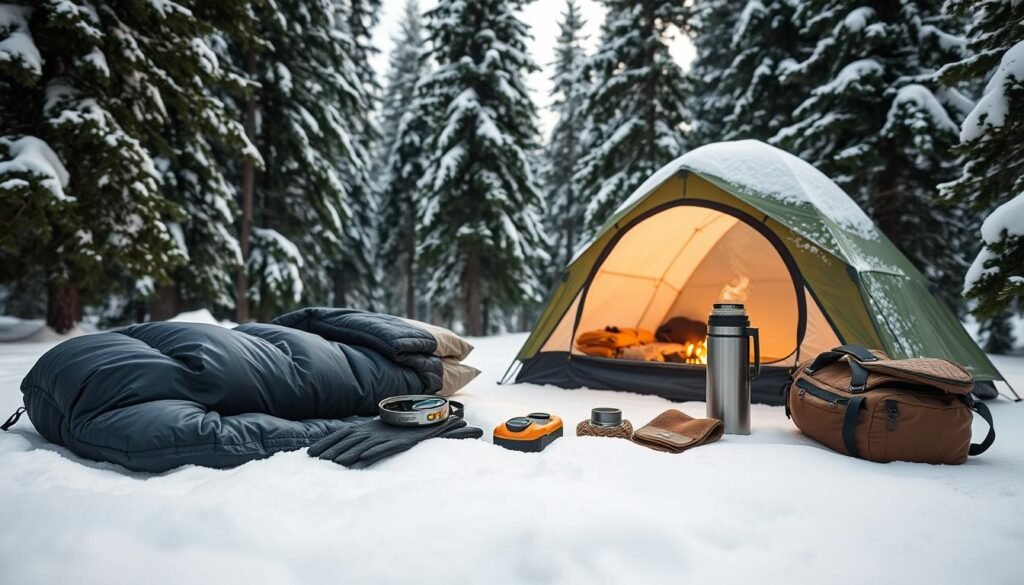When it gets cold, camping outdoors can feel like a challenge. But with the right gear and preparation, you can stay warm and cozy, even on the coldest nights.
Picture this: you’re all snuggled up in your sleeping bag, surrounded by nature’s quiet. You don’t need a big campfire to feel comfortable. It’s a mix of adventure and warmth.
Key Takeaways
- Essential gear for a cozy camping experience
- Tips for staying warm without a campfire
- How to choose the right camping equipment
- Preparation is key to a comfortable camping trip
- Staying safe and warm in cold weather
Why Cold Weather Camping Demands Special Preparation
Cold weather camping is more than just facing the cold. It’s about being ready for the special challenges it brings. When it gets colder, the outdoors becomes tougher, needing campers to change their plans and gear.
Common Challenges of Chilly Night Camping
Camping in the cold has its own set of problems. These include hypothermia, frostbite, and feeling too cold. Hypothermia happens when you lose heat too fast, leading to a very low body temperature. Frostbite occurs when skin and tissues freeze from being in the cold too long. It’s key to know these risks and how to avoid them.
| Challenge | Description | Prevention Measure |
|---|---|---|
| Hypothermia | Dangerously low body temperature | Layered clothing, warm sleeping bag |
| Frostbite | Freezing of skin and tissues | Proper insulation, limiting exposure |
| Discomfort | Feeling cold and uneasy | Warm clothing, hot beverages |
When Campfires Aren’t an Option: Restrictions and Alternatives
There are times when you can’t have a campfire, like when it’s banned or the weather is bad. In these cases, you need other ways to stay warm. Portable heaters and must-have travel gadgets like hand warmers can be very helpful. Knowing the local rules and having the right outdoor travel essentials can greatly improve your comfort and safety.

Camping Setup for Chilly Nights: My Complete System
Keeping warm without a campfire is a challenge. I’ve learned a layered approach to warmth that works well.

The Layered Approach to Warmth Without Fire
Layering is key to staying warm. I use different parts that keep my body heat in. My setup includes:
- A high-quality sleeping bag rated for sub-freezing temperatures
- A sleeping pad with a high R-value to insulate from the ground
- A tent designed for four-season use, with features like waterproof and breathable fabric
- Insulating clothing layers, including base, mid, and outer layers
Each layer is important for warmth. For example, my sleeping bag keeps me warm in very cold weather.
How My System Evolved Through Trial and Error
My camping gear has changed a lot over time. At first, I had basic stuff. But through trial and error, I found what works best. I got top-rated outdoor gadgets like portable heaters and advanced sleeping bags. They made my camping better.
Some important lessons I learned are:
- The importance of a good sleeping pad for ground insulation
- The value of dressing in layers to adjust to changing temperatures
- The need for a reliable and waterproof tent
By improving my setup with experience and top-rated outdoor gadgets, I stay warm and comfy, even on the coldest nights.
The One Outdoor Gadget I Never Travel Without Anymore
There’s one outdoor gadget that’s become a must-have for my cold-weather camping trips. I’ve tried many items, but this one stands out. It keeps me warm and comfortable.

Why This Became My Essential Cold Weather Companion
This gadget is a portable, battery-powered heater. It has changed my camping trips for the better. It’s small, light, and made for the outdoors.
It’s key because it gives consistent warmth. You don’t need a campfire, which is great when you can’t have one.
How to Maximize Its Effectiveness in Your Setup
To use it best, pair it with a well-insulated tent and a warm sleeping bag. Place it near your bed for a cozy night.
Also, use it in low-power mode to save battery. And check it has safety features like automatic shut-off to avoid accidents.
Creating the Perfect Sleeping System for Sub-Freezing Temperatures
A good night’s sleep in freezing temperatures starts with the right sleeping system. It’s not just about a sleeping bag. You need several key components to stay warm and comfortable.
Sleeping Bag Selection: Temperature Ratings Explained
Choosing the right sleeping bag is crucial. Look for bags with a comfort rating that matches the lowest temperature you expect. Sleeping bags are rated using an EN standard. This includes a comfort rating, a lower limit rating, and an extreme rating.
Understanding these ratings helps you select a bag that will keep you warm. For sub-freezing temperatures, a bag with a comfort rating below freezing is essential.

Sleeping Pads and R-Values: The Ground Cold Solution
A sleeping pad is just as important as your sleeping bag. It provides insulation from the cold ground. The R-value measures the pad’s ability to resist heat flow.
For sub-freezing temperatures, you’ll need a pad with a high R-value. Different types of sleeping pads, such as inflatable or foam, offer varying levels of insulation and comfort.
Liners, Quilts, and Other Sleeping Bag Enhancements
To further enhance your sleeping system’s warmth, consider using a sleeping bag liner. Quilts are another option, offering flexibility and warmth without the confinement of a traditional sleeping bag. Other enhancements include using a sleeping bag with a waterproof and breathable shell, or adding a warm hat and gloves to your sleeping attire.
By carefully selecting your sleeping bag, sleeping pad, and additional enhancements, you can create a sleeping system that will keep you warm even in the coldest conditions. This makes your camping experience more enjoyable.
Shelter Strategies: Turning Your Tent Into a Heat Trap
Keeping warm in your tent is key for cold weather camping. It’s not just about the tent type. How you set it up, insulate, and ventilate it matters too.

Four-Season vs. Three-Season Tents: Making the Right Choice
Choosing between a four-season and a three-season tent is important for cold weather camping. Four-season tents handle heavy snow and strong winds well. They’re made of stronger materials and have better insulation than three-season tents.
Key features to look for in a four-season tent include:
- Waterproof and breathable fabric
- Reinforced poles for wind resistance
- A design that allows for snow loading
Positioning, Insulation, and Ventilation Techniques
Choosing the right spot for your tent is crucial. Find a place that’s protected from wind and has good drainage. Use a footprint or ground tarp for better insulation. Make sure your tent has good ventilation to avoid moisture buildup.
Effective ventilation techniques include:
- Using vents at the top of the tent
- Adjusting the tent’s doors and windows for airflow
- Avoiding cooking inside the tent to reduce moisture
By using these strategies, you can make your camping trip more comfortable, even in cold weather. As outdoor lovers say, “
A good shelter is the foundation of a comfortable camp.
“
Clothing Layers: Your Mobile Personal Heating System
Layering is key for staying warm while camping in the cold. It lets you adjust your clothes based on how active you are and the weather. This keeps you comfy all trip long.
Base Layer Materials That Outperform in Cold Conditions
The base layer is closest to your skin. Merino wool and synthetic fabrics like polyester are top picks. They keep you dry and warm, even when wet. For example, Smartwool merino wool base layers are known for their warmth and comfort.
Mid-Layer Insulation: Down vs. Synthetic Options
Mid-layers are the main insulators, keeping you warm. Down, like in Patagonia’s down jackets, is light but loses heat when wet. Synthetic, like PrimaLoft, stays warm when damp, perfect for rainy days.
Outer Shell Features for Wind and Moisture Protection
The outer shell guards against wind, rain, and snow. Look for ones with Gore-Tex or eVent for waterproofing. Adjustable cuffs and hem help keep warmth in. For example, The North Face’s Venture 2 jacket offers strong weather protection.
| Layer | Material | Key Features |
|---|---|---|
| Base Layer | Merino Wool, Synthetic | Moisture-wicking, warmth retention |
| Mid-Layer | Down, Synthetic Insulation | Warmth, lightweight |
| Outer Shell | Gore-Tex, eVent | Waterproof, breathable, windproof |

Knowing how each layer works and picking the right materials makes a great camping outfit. This layered system keeps you warm and makes camping more fun.
“Layering is not just about adding more clothes; it’s about creating a system that adapts to your needs and the environment.” – Experienced Camper
Must-Have Travel Gadgets for Cold Weather Camping
To enjoy camping in cold weather, you need the must-have travel gadgets for safety and comfort. Camping in the cold can be exciting, but you must prepare well. The right gear is key to staying warm and safe.

Portable Heating Solutions: Battery Life and Safety
Portable heaters are essential for cold weather camping. When picking a heater, think about battery life and safety features. Look for heaters with long battery life and safety features like automatic shut-off. This prevents accidents.
Brands like Goal Zero and Jackery offer safe and efficient portable heaters.
Tech Accessories That Enhance Comfort in the Cold
There are also tech accessories that boost comfort in the cold. These include heated clothing, portable power banks, and waterproof Bluetooth speakers. For example, heated insoles can keep your feet warm. A portable power bank keeps your phone or GPS charged.
Buying these outdoor travel essentials can greatly improve your camping. The right gadgets let you enjoy nature’s beauty, even in the coldest weather.
Food and Drink: Fueling Your Internal Furnace
The right food and drink are key on a cold camping trip. Your body needs more energy to stay warm outside. This section will show how to fuel up with calorie-rich meals and hot drinks.
Calorie-Dense Meal Planning for Cold Weather Energy
High-calorie meals are vital for energy in cold weather camping. Foods high in protein and fat work best. Pack dried meats, nuts, and energy bars.
Think about instant noodles with dried veggies and meat, or a dehydrated meal. A simple meal can be as good as a fancy one.
A sample meal plan might include:
| Meal | Food Items | Calories |
|---|---|---|
| Breakfast | Oatmeal with nuts and dried fruits | 600 |
| Lunch | Dried meat sandwich, energy bar | 800 |
| Dinner | Dehydrated stew with bread | 1000 |
Hot Beverage Systems and Insulated Containers Worth the Weight
Hot drinks keep you warm and cozy. Insulated containers keep drinks hot for hours. Choose a thermos or vacuum-insulated bottle.
For hot drinks, try tea, coffee, or hot chocolate. Make them with hot water from a portable stove or camping heating solutions.
“A good cup of tea can be a lifesaver on a cold day.” – Anonymous camper
A good insulated container is worth the extra weight. It keeps drinks hot and saves time on reheating.

Pre-Trip Preparation: Setting Yourself Up for Success
Before you start your cold weather camping trip, make sure you’re ready. This means packing the right gear and knowing what to expect. It also means testing your equipment to make sure it works.
Weather Forecasting Tools and Contingency Planning
Using good weather apps is key to getting ready for the weather. Apps like Dark Sky or The Weather Channel give you detailed forecasts. This helps you plan your trip and make changes if needed.
It’s also important to have a backup plan. Know where the nearest shelters are. And have a plan for bad weather.
Testing Your System Before You’re Miles from Civilization
Test your camping gear before you leave. Check your top rated outdoor gadgets like portable heaters and insulated containers. Also, make sure your sleeping bag keeps you warm in cold weather.
Testing at home helps you find any problems. This way, you can fix them before you’re on your trip. This helps avoid any issues during your adventure.

Top Rated Outdoor Gadgets That Transformed My Winter Camping
The right gear can make a big difference in winter camping. I’ve found some top-rated gadgets that really work. I’ve tried different equipment to make my camping better, and I’m happy to share what I’ve learned.
Innovative Warming Solutions That Actually Work
I’ve found some amazing warming solutions. For example, a portable, battery-powered heating pad is now my best travel companion gadget. It’s light, efficient, and keeps me warm where I need it most. I also use a heated sleeping bag liner for extra warmth on cold nights.
“The best way to get started is to quit talking and begin doing.” – Walt Disney
These solutions have made camping much more comfortable. I can now camp in conditions I thought were too harsh before.
Multi-Purpose Gear That Justifies the Investment
I’ve also invested in multi-purpose gear. A portable power bank is a great example. It can charge my devices, light, and even a small heater. This gear is worth the money because it does so much.
| Gadget | Primary Use | Secondary Use |
|---|---|---|
| Portable Power Bank | Charging Devices | Powering Small Heater |
| Heated Sleeping Bag Liner | Extra Warmth | Comfort on Chilly Nights |
| Battery-Powered Heating Pad | Personal Warmth | Relief for Muscle Tension |
Adding these top-rated gadgets to my winter camping gear has greatly improved my experience. Whether it’s innovative warming solutions or multi-purpose gear, the right equipment makes a big difference.
Adapting Your Setup for Different Cold Weather Conditions
Understanding and adapting to different cold conditions is key for a great camping trip. Whether it’s damp, dry, or windy, your setup must be flexible. It needs to respond well to the environment.
Damp Cold vs. Dry Cold: Adjusting Your Strategy
Damp cold is tough because it gets into your gear and makes it less warm. You need waterproof gear and clothes and sleeping bags that don’t let moisture in. Dry cold, on the other hand, is about keeping warm without getting wet. You should use breathable clothes and layer up.
| Condition | Key Strategies | Must-Have Gear |
|---|---|---|
| Damp Cold | Waterproofing, Moisture Resistance | Waterproof jackets, Moisture-resistant sleeping bags |
| Dry Cold | Layering, Breathable Fabrics | Breathable base layers, Insulating mid-layers |
Elevation, Wind, and Environmental Considerations
As you go higher, it gets colder and windier. You need to pick the right gear and plan your campsite carefully. Windproof tents and clothes are a must-have travel gadget for windy places. Knowing the local weather helps you set up your camp better.
“The best preparation for cold weather camping is understanding the conditions you’ll face and adapting your gear and strategies.”
Being ready and flexible lets you enjoy camping even in harsh cold weather.
Conclusion: Embracing the Chill with Confidence and Comfort
Camping in chilly nights doesn’t have to scare you. With the right gear, you can stay warm and cozy. I’ve found that one outdoor gadget makes a huge difference.
Using a layered approach to warmth is key. Choose the right sleeping bag and shelter. Don’t forget portable heating and insulated containers for hot drinks.
Preparation is key. Check the weather and test your gear before you go. With the right equipment, you can enjoy camping in the cold.
Whether you’re experienced or new to camping, the right mindset and gear matter. So, get ready, stay warm, and enjoy nature’s beauty in the cold.

